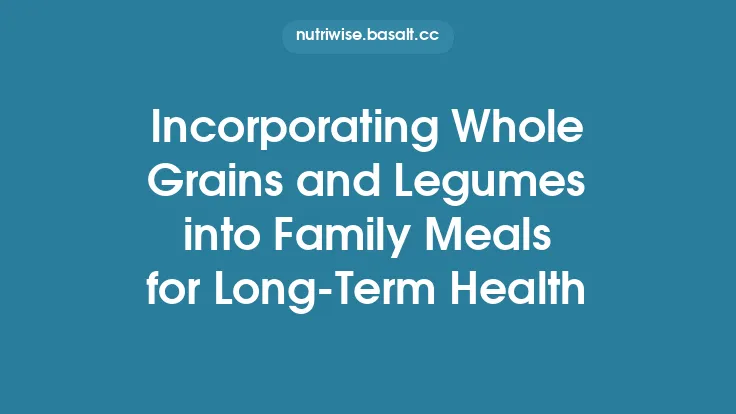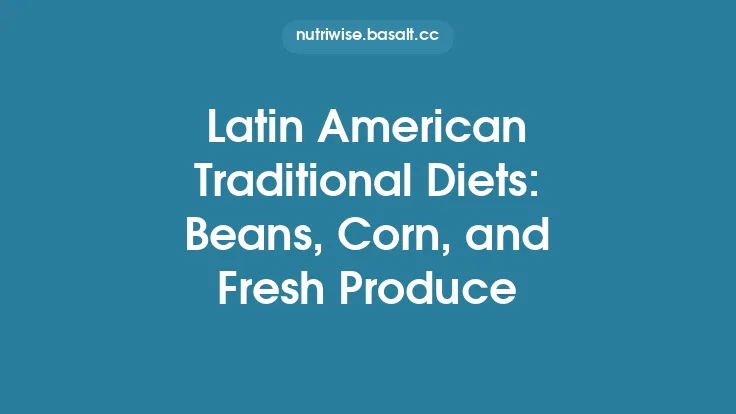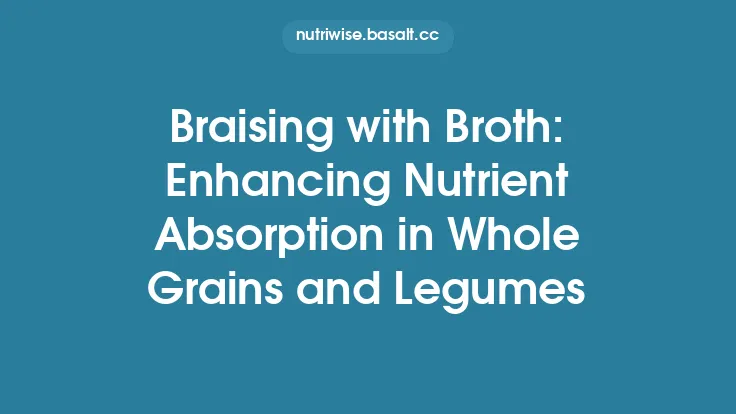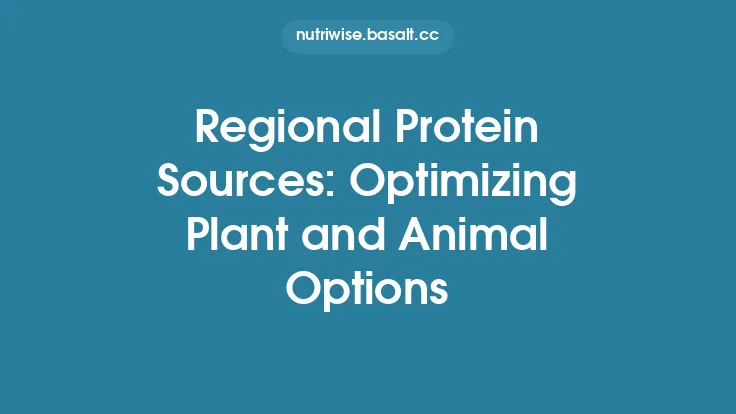African regional diets are as varied as the continent’s landscapes, climates, and cultures. From the arid Sahel to the lush highlands of East Africa, staple grains and legumes have shaped daily meals, seasonal celebrations, and agricultural practices for millennia. These foods are not merely sources of calories; they provide a complex matrix of macronutrients, micronutrients, phytochemicals, and dietary fiber that support health across the life course. Understanding the diversity of nutrient‑dense grains and legumes in Africa offers insight into how traditional food systems can inform contemporary nutrition strategies, agricultural policy, and sustainable development.
Geographic Diversity of African Grains
| Region | Primary Grain(s) | Climate Adaptation | Notable Varieties |
|---|---|---|---|
| West Africa | Millet (pearl, finger), sorghum, fonio | Drought‑tolerant, short growing season | *Pennisetum glaucum (pearl millet), Sorghum bicolor (white sorghum), Digitaria exilis* (fonio) |
| East Africa | Teff, barley, maize | Highland cool temperatures, occasional frost | *Eragrostis tef (teff), Hordeum vulgare (barley), Zea mays* (flint maize) |
| Central Africa | Cassava (starchy tuber, often classified with grains), rice | Humid tropical, high rainfall | *Manihot esculenta (cassava), Oryza glaberrima* (African rice) |
| Southern Africa | Sorghum, millet, maize | Semi‑arid to temperate zones | Drought‑resistant sorghum hybrids, *Zea mays* (yellow dent maize) |
| North Africa (Sahara fringe) | Durum wheat, barley | Mediterranean‑type, limited rainfall | *Triticum durum (durum wheat), Hordeum vulgare* (barley) |
These grains differ markedly in protein quality, mineral content, and glycemic response. For instance, teff contains up to 8 % protein with a balanced amino‑acid profile, while fonio is celebrated for its high lysine content—a limiting amino acid in many cereals. Sorghum’s phenolic compounds confer antioxidant properties, and millet’s low glycemic index makes it suitable for sustained energy release.
Key Nutrient‑Dense Legumes Across the Continent
Legumes complement grains by supplying essential amino acids, iron, zinc, and folate. The most widely cultivated African legumes include:
- **Cowpea (*Vigna unguiculata*)** – Predominant in West and Central Africa; rich in protein (≈ 24 % dry weight) and resistant starch.
- **Pigeon pea (*Cajanus cajan*)** – Grown in East Africa; notable for high calcium and vitamin B6.
- **Lentils (*Lens culinaris*)** – Cultivated in the Ethiopian highlands; excellent source of folate and iron.
- **Groundnut (peanut, *Arachis hypogaea*)** – Ubiquitous across sub‑Saharan Africa; provides monounsaturated fats, vitamin E, and magnesium.
- **Soybean (*Glycine max*)** – Increasingly important in Southern Africa for its high‑quality protein and isoflavones.
These legumes are often intercropped with cereals, a practice that enhances soil nitrogen fixation, reduces pest pressure, and improves overall farm resilience.
Culinary Traditions and Preparation Techniques
African cuisines employ a spectrum of processing methods that influence nutrient bioavailability:
- Fermentation – Traditional sourdoughs such as *injera (teff) and ogi* (millet) involve lactic‑acid bacteria that degrade antinutrients (phytates) and increase mineral absorption.
- Germination (Sprouting) – Sprouted sorghum and millet are used in porridges, boosting vitamin C and B‑vitamin levels while reducing trypsin inhibitors.
- Roasting and Toasting – Roasted fonio and toasted millet flour (used in *koko or fufu*) develop Maillard reaction products that enhance flavor and may provide antioxidant activity.
- Milling and Sieving – Fine milling of teff into flour for flatbreads preserves fiber, whereas coarse milling of sorghum for *ugali* retains more bran and associated micronutrients.
- Stewing and Slow Cooking – Legume‑rich stews (e.g., *maafe with groundnut, maraq* with cowpea) allow prolonged heat exposure, which can improve protein digestibility and release bound iron.
These culinary practices are not merely cultural artifacts; they are functional strategies that optimize the nutritional yield of locally available crops.
Nutritional Profiles and Health Implications
Macronutrients
- Carbohydrates – Grains such as millet and sorghum provide complex carbohydrates with a low to moderate glycemic index, supporting stable blood glucose levels.
- Proteins – When combined (e.g., millet + cowpea), the complementary amino‑acid profiles achieve a protein quality comparable to animal sources (PDCAAS ≈ 0.9).
- Fats – Groundnut and soybean contribute essential fatty acids, particularly linoleic and α‑linolenic acids, which are precursors to long‑chain omega‑3s.
Micronutrients
| Food | Iron (mg/100 g) | Zinc (mg/100 g) | Calcium (mg/100 g) | Folate (µg/100 g) |
|---|---|---|---|---|
| Fonio (raw) | 2.5 | 2.1 | 30 | 30 |
| Teff (raw) | 3.6 | 2.5 | 180 | 40 |
| Cowpea (cooked) | 3.0 | 2.0 | 50 | 150 |
| Groundnut (raw) | 2.5 | 3.3 | 70 | 240 |
These values illustrate the capacity of African staples to meet daily micronutrient requirements, especially when consumed in diversified meals.
Phytochemicals and Functional Compounds
- Phenolic acids in sorghum (e.g., ferulic acid) exhibit anti‑inflammatory activity.
- Flavonoids in fonio and millet contribute to antioxidant defenses.
- Resistant starch formed during cooling of cooked grains improves gut microbiota composition, fostering short‑chain fatty acid production linked to colonic health.
Collectively, these components support cardiovascular health, glycemic control, and immune function, aligning with contemporary nutrition recommendations.
Agricultural Practices and Food Security
African smallholder farms often employ mixed cropping systems that integrate grains and legumes. Benefits include:
- Biological nitrogen fixation by legumes, reducing dependence on synthetic fertilizers.
- Diversified harvest windows, mitigating risk from climate variability.
- Soil structure improvement through deep‑rooted sorghum and millet, enhancing water infiltration.
Recent advances in biofortification—such as iron‑enriched pearl millet (variety ‘Dhanashakti’) and zinc‑enhanced sorghum—demonstrate the potential to amplify nutrient density without altering traditional culinary uses.
Modern Adaptations and Global Influence
Urbanization and diaspora movements have spurred innovative applications of African grains and legumes:
- Gluten‑free products: Teff flour is now marketed worldwide for its high protein and mineral content, finding use in breads, crackers, and pasta.
- Plant‑based protein isolates: Cowpea and pigeon pea protein powders are incorporated into meat analogues, catering to global flexitarian trends.
- Functional beverages: Fermented millet drinks (e.g., *bissap* variants) are being commercialized as probiotic-rich refreshments.
These adaptations preserve cultural heritage while meeting contemporary consumer demands for nutrient‑dense, sustainable foods.
Challenges and Opportunities for Sustainable Development
Despite their nutritional promise, African grains and legumes face several constraints:
- Post‑harvest losses – Inadequate storage leads to up to 30 % loss of millet and sorghum due to pests and moisture.
- Market access – Smallholder producers often lack reliable value chains, limiting income and investment in improved varieties.
- Research gaps – Limited agronomic data on climate‑resilient legume cultivars hampers scaling of nitrogen‑fixing systems.
Addressing these issues requires coordinated action:
- Improved storage technologies (e.g., hermetic bags, solar dryers) to reduce losses.
- Strengthened farmer cooperatives that negotiate better prices and facilitate knowledge exchange.
- Investment in breeding programs focused on drought tolerance, disease resistance, and enhanced micronutrient profiles.
By leveraging traditional knowledge alongside modern science, African regional diets can continue to provide nutrient‑dense sustenance while contributing to food sovereignty and ecological balance.
In sum, the grains and legumes that anchor African culinary traditions are a reservoir of high‑quality protein, essential minerals, and bioactive compounds. Their diverse preparation methods enhance nutrient availability, and their integration into resilient agricultural systems underscores their role in both cultural identity and public health. Continued research, policy support, and market development will ensure that these nutrient‑dense staples remain a cornerstone of sustainable nutrition for generations to come.





